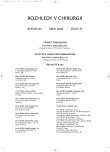Arthroscopic Management of Traumatic Luxation of the Patella
Authors:
L. Paša; S. Kalandra; I. Melichar; A. Bilik; R. Suchomel
Authors‘ workplace:
Klinika traumatologie LF MU Brno, přednosta: prof. MUDr. Peter Wendsche, CSc
Published in:
Rozhl. Chir., 2006, roč. 85, č. 10, s. 530-535.
Category:
Monothematic special - Original
Overview
Aim:
The authors present a restrospective assessment of acute traumatic patellar luxation.
Material:
From 1999 to 2003, the authors treated 57 patients with acute traumatic patellar luxations, including 36 females and 21 males, the age range was 16–40 years. In cases of marked lateralization of the patella, the injured medial retinaculum was sutured under arthroscopic control. Furthermore, should the lateralization persist, lateral release of the patella was conducted. Early patellar cartillage injuries were detected in 34 subjects (59%), injuries of the lateral femoral condyle in 19 subjects (33 %). Patellar chondromalacia, grade 1–2 was diagnosed in 16 subjects. Free cartillagenous particles within the joint were detected in 18 subjects. Reconstruction of the cartillage was conducted in extensive injuries in 13 subjects.
Results:
The subjects were assessed 1–4 years after the injuries and surgery. In one case (2%), a relaps of the patellar luxation, due to a new contact sport injury (a direct impact), was recorded. Assessment results, using the Lysholm score, were defined as follows: 93%-excellent and good, 7% fair.
Conclusion:
Sparing surgical techniques, followed by appropriate rehabilitation care, may optimalize the healing process of the injured tissue and prevent relapses of patellar luxations, as well as further wearing of femoropatellar cartillages.
Key words:
patella – luxation – arthroscopy – stabilisation
Labels
Surgery Orthopaedics Trauma surgeryArticle was published in
Perspectives in Surgery

2006 Issue 10
Most read in this issue
- Arthroscopic Management of Traumatic Luxation of the Patella
- Complications of the Longo Procedure – Rectal Occlusion
- Morgagni Diaphragmatic Hernia in Childhood
- Rates and Histological Characteristics of Rectal Polyps in Childhood
